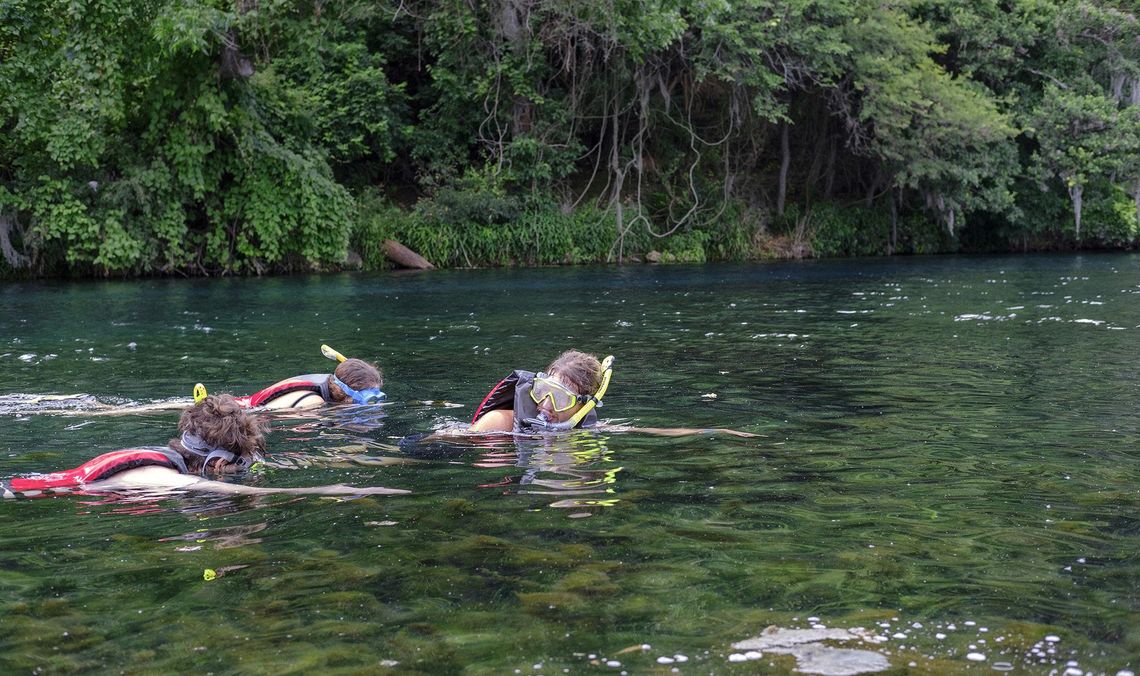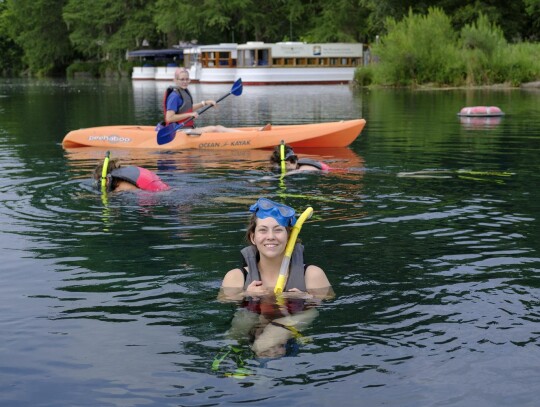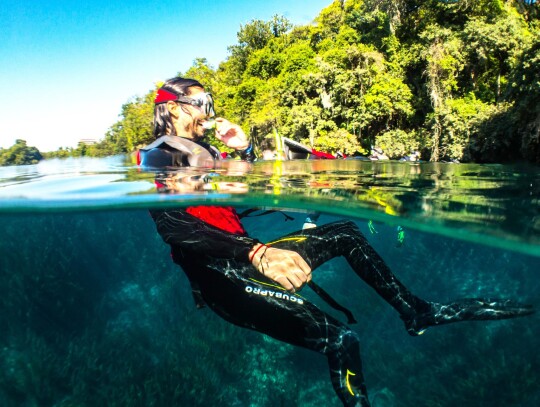Going beneath to see, experience local nature
The Meadows Center hosts a guided snorkel tour of Spring Lake every couple of weeks with a small group. The group is limited in size in order to preserve and protect the natural habitat of some of its endangered species. I participated this past Saturday, and it was truly a magnificent experience.
Deputy Director of Spring Lake Education Miranda Wait said Spring Lake is protected by the Endangered Species Act.
“There are regulations set in place to preserve the space, and that’s through the Habitat Conservation Plan and the Spring Lake Access Plan,” Wait said. “We’re really strict on how much access we allow in the lake.”
Wait added that allowing full access to the lake could introduce invasive species such as zebra mussels and other creatures that could negatively impact the naturally occurring species’ habitat.
For $45, the Meadows Center supplies you with a wetsuit–very necessary in the spring fed water that stays a constant 72-degrees, goggles and a snorkel, as well as facts about the lake along the way.
At one point, I swam with a family of five turtles– it was majestic. And throughout the entire lake, the view to the bottom was incredibly clear–even at the deepest parts.
The environmental interpreters that guided my tour were Julian Moreno, Madison Darwish and Callum Sparrow–all students at Texas State University and all very knowledgeable about the lake.
I swam over Deep Hole– the deepest spot in the lake. Darwish said a local Native American tribe is deeply intertwined with the springs located there.
“Those springs are considered sacred springs by the Miakan-Garza tribe–a local Coahuiltecan tribe that is Native to this area. [They] believe their creation began from those springs, so take it in … it’s very sacred,” Darwish said. “For thousands of different tribes for thousands of years, people have relied on this water, and still to this day, people rely on this water. This water is what connects us all.”
Wait elaborated further on the Miakan-Garza origin story.
“[They believe] They actually came from that fault line where Deep Hole is. That is where they came from the underworld,” Wait said. For more information on the Coahuiltecan origin story, visit this link meadowscenter.txst.edu/ education/online-learning- hub.html.
I then swam over the remnants of an archaeological dig site that can be seen from the tour. Wait said the dig was spearheaded in the late 70s and early 80s by an archaeologist, Dr. Joel Shiner, and they found spearheads, pottery and different animal bones.
“What the archaeologists said is that people have been persistently coming to Spring Lake for over 13,000 years, so they say it's one of the longest persistently inhabited places in North America,” Wait said.
The tour takes you right over the fault line that divides the hill country via the Balcones fault line.
“The Balcones Escarpment divides the Texas Hill Country and the Blackland Prairie which is eventually the Texas Gulf Coastal Plains. It goes all the way from Arkansas to Mexico –the escarpment does, but the real fault line is mainly above the Aquifer which is Del Rio out to Waco. It follows the I-35 Corridor,” Sparrow said.
Sparrow said the first hill of the Texas Hill Country is located just beside the lake, and the Hill Country itself started with a natural disaster.
“65 million years ago an earthquake divided those two segments,” Sparrow said. “When it did, it pulled this segment toward the ocean, so it got flatter and more stretched out, but what happened with that segment is that it got pushed toward the rest of North America and the rest of Texas. So, if you can imagine taking a piece of printer paper and pushing both sides toward each other … it can’t stay flat.”
Wait said the balcones fault line is no longer active and hasn’t been for approximately 15 million years. She added that it is a direct path into the aquifer.
Sparrow said you can trace a lot of Central Texas natural highlights to the fault line.
“You have all the rivers along the I-35 Corridor– Comal Springs, San Marcos Springs, [and] Barton Springs. You also have all of the cave attractions that are along that fault line. [There’s] even Hamilton Pool and Little Dead Man’s Hole … Jacob’s Well. All of that is part of this big earthquake that created little gaps in the limestone for the Edwards Aquifer to then release the water,” Sparrow said.
Sparrow said that around 70 million years ago, Texas was underneath a shallow ocean that was part of the Gulf of Mexico.
“When that receded, all of the microorganisms and stuff that had been tumbled dry settled down, and that’s what created the limestone. Then the sun compacted all of that,” Sparrow said. “The limestone is really all created from old fossils and sand, so we’re using old, old ocean creatures to filter the water as it goes down [into the aquifer], and then it comes back up at ‘99.8% purity. So, it’s cleaner than our tap water at home.”
While swimming I saw a yellow spotted fish which had a long alligator-looking mouth and was about a foot and a half long–I had never seen anything like it. Moreno informed me that this was a Yellow Spotted Gar which is unique in that it can breathe under the water as well as above it.
Wait said the Yellow Spotted Gar is closely genetically related to its prehistoric ancestors from the Cretaceous Period–the last period in which dinosaurs roamed the earth, and this is the reason for their odd appearance.
Darwish said there are several endangered species of plants and animals that reside at the lake. Texas Wild Rice is an endangered plant that covers the majority of the San Marcos river and is also very abundant at the dam that divides the lake from the river.
Moreno said there is the Texas Blind Salamander–an endangered species–that resides in the aquifer, so not technically in the lake but just below it in the water that feeds the springs in the lake.
“The Texas Blind Salamander only exists here. It's an incredibly unique species. Just their existence, itself, is amazing–they are completely blind,” Moreno said.
Sparrow said the Texas blind salamander has evolved to fit its current home deep underwater and now has a film over the eye sockets and no eyes. He said the existence of eye sockets in this species lend to the fact that it was once closer to the surface and had the ability to see.
“When Texas dried out from ocean to land, It was during an insane drought … While that sea mud was petrifying and solidifying, there were cracks that formed, and there were creatures seeking refuge down in the shaded spots in the cracks, and they were slowly finding their way farther and farther down which would have started that process of adapting to see less, [but] feel and smell more,” Sparrow said.
Wait said there are certain conditions that can lead to a Texas Blind Salamander spotting in the lake, but I wasn’t lucky enough to see one.
“When we’re having a good flow year and the springs are really bubbling, it’s not uncommon for a Texas Blind Salamander to get pushed up out of the aquifer,” Wait said.
Darwish said the lake is home to the San Marcos Salamander–a native species.
“Salamander’s rely on spring openings because it’s the perfect habitat–it stays the same temperature and the water quality is on point,” Darwish said. “The San Marcos salamander is proof that these springs haven’t dried up as long as that little guy has been around or it would have gone extinct.”
Wait said another endangered species you might see on the tour is the Fountain Darter. According to Texas. gov, this fish lives in the San Marcos and Comal rivers and requires clean, spring fed water and bottom vegetation to thrive–of which we have plenty with the abundant Wild Rice.
Sparrow said there are naturally occurring North American Eels in the lake –which I was not fortunate enough to see. That was not for lack of trying, though–we swam over the area where they are most frequently seen.
Go to this link to register for one of the many tour dates, https://www.meadowscenter. txst.edu/education/ snorkelprogram.html.





